Hey, this is a relatively informal post. Recently I came back to a book that I had read five or six years ago, and it inspired me to share something with you that I wish someone would’ve shared with me ages ago. Maybe this is a failure of my early education, but at no point did I ever have a history teacher share this bit of wisdom with me, and unfortunately it was something I had to discover on my own—The beginning of every good history book starts with a map, because understanding that map is a prerequisite to the material within. Some maps are better than others.
Maybe you’re just getting started in your journey of Western Martial Arts, Historical European Martial Arts, or maybe you just have a desire to learn more about Italian Medieval and Renaissance history. I think that’s why you would be here, I could be wrong. That said, if you are like 99.9% of human beings you probably also feel like historical non-fiction is really difficult to understand. Good news, you’re not alone!
Understanding history means understanding layers of information; names, kingdoms, republics, regions, cultural norms, civics, classics, the list goes on and on. It’s a lot. I get it. It can be overwhelming. But I want to share some tricks, maybe I’ll make more posts like this in the future, resources to get more people interested in the historical research of the arts we practice.
Let’s start with some maps.
My first go to when I study a map, especially if I’m studying military history is to learn the rivers and the mountains, the physical obstacles an army would have to contend with. It’s also important because most major cities all across the world are usually located near rivers—water is a basic necessity of human life, after all. So let’s look at the rivers and mountains of Italy.
First objective major rivers:
Next mountain ranges:
It might help to make some flash cards, test yourself, or find a good app that quizzes you on geographic features. Once you have those down, we’ll have to dig a bit deeper, this is where things might start feeling overwhelming, so perhaps, rather than trying to take it all in on one go, it will help to focus on a region. Northern Italy perhaps!
Let’s look at the minor rivers in Italy:
Not the best map, because it’s cut off, but you get the picture, maybe you can find a better one and share it with us. Either way, you can see that Italy has way more rivers than the Po, Adige, Reno, Tiber, ect.
Now that you’ve got a good picture of the major geographical characteristics of Italy, it’s time to start looking at cities. Again, this is going to be information overload, but take it slow. Maybe pick a region, or look specifically for cities you’ve heard about from your current studies, or that you’ve read about in the past. Where is Rome, Bologna, Milan, Ferrara, Perugia, Napoli, Firenze (Florence), Venice, ect.
Let’s look at the major cities of Italy:
Take your time, make a game of it, and have fun. The key here is familiarization, when you read a good book on Italian history, you’ll want to have an idea of where these cities are located, what geographical features surround those cities, and what cities are nearby. It’ll help, I promise. Instead of reading about how an army approached Bologna from Ferrara, and had to cross the Reno river, and getting the sensation that your eyes are rolling back into your head, and slapping yourself awake—you’ll say, “hey I know where that is!”
It’s exciting, I promise, just bear with me, and trust the process.
Next up are the regions of Italy, these are just as important as the cities that compose these regions, and they’re usually divided by major geographic features.
Let’s look at the Regions of Italy:
This one is fun, if you like wine, try to drink a different wine from each region, throw some cities in there too, try to pinpoint the rivers and mountains in each region, again, make a game of it—have fun! Now when you hear about armies rummaging through the Romagna, Campania, or the Marches, you’ll know what the author is talking about, you’ll know the geographical features of those areas, and you’ll know what cities were near by. Find some different maps, maybe some more complex maps where all of this information is collated together, and study those.
The point of this exercise, and the process I’m trying to highlight is, the best way to eat an elephant is one bite at a time. Italy is complex, the world is complex. If you want to allow yourself to focus on the people, the dates, and the details of any good historical narrative, it helps to do the leg work, and eliminate the constanstants that make historical non-fiction overwhelming. If you learn the parts that don’t change, the fixed features of a landscape, and large municipal centers, the cultural regions, then you’ll have the bandwidth to focus on the fun parts. Trust me, history is fun, it’s better than your favorite fantasy, or serial drama, the characters are more complex, the stories are more compelling, and it’s revealing to learn about the human condition from the folks who lived it. There are immense cautionary tales, lively heroes, powerful villains, and touching moments of compassion and love. It’s all there, waiting for you to embrace it, and this is the first step to falling in love with what came before.
I hope this helps! Let me know in the comments if you’d like us to do more of these, we can focus on different regions, and build a resource library.









